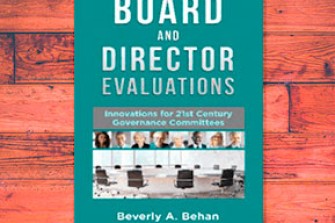Governing boards do much of their work in formal board meetings. Continuously improving the planning and conduct of board meetings is therefore central to board (and director) effectiveness. One book dealing with board meetings we have referred to often over the years is Alice Collier Cochran’s Roberta’s Rules of Order. [1]
The title is a play on (General) Robert’s Rules of Order. According to Wikipedia, ‘Robert’s Rules’ is the most commonly adopted parliamentary authority among societies in the US and recognised as the most widely used reference for meeting procedure and business rules in the English-speaking world. That doesn’t mean these are perfect. Rigidly applied meeting rules often stifle meaningful dialogue and inhibit the process of discovering agreements that have the genuine commitment of meeting participants. They advantage those who best understand the rules (or say they do), while forcing others to take a back seat. Those who are naturally quiet and thoughtful, or who hold back because of a lack of confidence or a self-perceived lack of status within the board, are disadvantaged. At a time when the value of diversity is being recognised, this suggests Robert’s Rules may be anachronistic.
On the face of it, this book is a tilt by Collier Cochran at the perceived formality and fussiness of Robert’s strictly applied rules for conducting meetings. Broadly we agree with that intent. However, as we have noted elsewhere in this issue of Good Governance, prior agreement on the strict application of formal meeting procedures can be a fallback for when boards struggle to agree on how to decide.
Collier Cochran says her initial motivation in writing this book was to suggest an alternative to reliance on parliamentary procedure. Her experience had showed her that when Robert’s Rules were abandoned out of frustration, the result was often a similarly problematic free-for-all. She was also motivated to help the average person newly elected to lead or serve on an advisory or nonprofit board of directors, to be successful in the role.
It is a longish book (250 pages plus appendices that include helpful templates) but given shape and continuity by the author’s use of nautical analogies drawn from her love of sailing and tall ships—adding colourful imagery to otherwise somewhat dry concepts.
A stated intention is to ‘deep six’ laborious meetings and heavy formal structures by synthesising methods that will simplify group procedures. This will be helpful for readers from newbie board members to experienced board chairs. We like the following succinct summary by another reviewer:
Cochran succeeds in what she sets out to do: Provide a less formal, more feminine, and flexible approach. She replaces formality with informality; strict rules with guidelines and agreements; parliamentary procedure with democratic principles and processes; language of the 1800s with that of today; military terminology with civilian terminology; one-size fits all with flexibility, by culture; a framework designed for English and European males with that for a pluralistic society; win-lose voting with win-win decisions; a decision between two choices with straw polls and multiple choices; highly controlled and constrained meetings with those that are relaxed; and complicated with simple.
As board advisors, chairs and discussion facilitators, we have benefitted from Collier Cochran’s practical and logical explanations of different ways to approach the many challenges of board meeting effectiveness. Chapter by chapter, these are worth study and application. This is an easy and engaging read, but it is not a book to read in one sitting. Better to scan initially for its overall content then use it as a professional development tool, working through topic by topic, or as a reference resource. This is helped by the structure the author uses for each chapter which includes:
- a summary of what you will learn
- a problem statement to set the scene
- a description of different ways of tackling the problem
- a summary
- a proposed action plan.
Broadly, the book traverses:
- the need for more flexibility in the conduct of meetings
- group decision-making processes
- managing meetings for greater engagement and better use of peoples’ time
- valuing and gaining benefit from diversity
- improving the infrastructure of governance.
Concepts that would repay close attention by most boards include:
- Structuring a decision process—for example, why it is advisable to discuss a problem before considering the solution. Fundamental logic, but too many boards rush in to tackle a raft of solutions before agreeing on the problem to which these supposedly relate.
- Deciding how to decide—on a matter (particularly one involving complexity and conflict) that needs a decision, is consensus the aim? What does ‘consensus’ mean to the members of your board? Unanimity? ‘I can live with it’ consent? Or ‘the sense of the group’? How to use concordance as a fall back.
- Planning (and concluding) an effective meeting—being clear about the outcomes expected from each meeting and designing an efficient flow of topics, giving priority to intended impact and (where relevant) urgency. We particularly like the advice to allow time at the end of the meeting (15 minutes) for reflection: how well did we do and how can we improve? This meeting conclusion phase gets a whole chapter.
- Expecting and respecting different frames of reference—exploring how culture influences reactions and participation and how to improve multicultural comfort in meetings. Increasing tolerance of different points of view.
- Moving from dialogue to debate—understanding the difference and what beliefs and behaviours are needed to have respectful (and productive) conversations. How to be a constructive participant in a group discussion. This topic perhaps relates most closely to the need for boards to have a productive relationship between members, and between board and management.
- Building strong but flexible structures—clarifying expectations of board members and why it is better for boards to be smaller (and can be if non-governance-related functions are delegated elsewhere). Also, the arguments for limiting the power of executive committees.
- The power of policies—Collier Cochran uses one of her sailing metaphors to emphasise how important policies are in a governance context. A yacht’s keel is essential to it staying upright and moving forward instead sideways. Like a keel, policies are seldom outwardly visible but are essential to organisational stability.
The author’s starting point is a critique of the kind of meetings that result from strictly applying formal meeting rules. But the content of this book is fundamentally useful as a guide to alternative ways of thinking about how to have more efficient, productive and satisfying small group meetings. [2]
As far as meeting rules go, respect and good manners should be preferred to prescriptive discipline and, whenever rules and prescribed procedures are considered unavoidable, everyone should be able to read them, remember them and use them easily.
Notes:
[1] Alice Collier Cochran (2004) Roberta’s Rules of Order, San Francisco, Jossey-Bass. Despite being published in 2004 it is still readily available from major book sellers.
[2] The author also suggests a better approach to the conduct of General Meetings.








